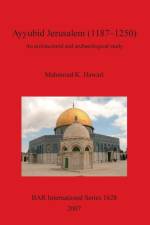- An architectural and archaeological study
av Mahmoud K Hawari
987
The conquest of Jerusalem by Saladin in 583/1187, after nearly nine decades of Frankish rule, opened a new era of cultural, socio-economic and architectural changes. The renewed political fervour that followed it gave a fresh impetus to an extensive building activity initiated by the Ayyubids, which signified a renaissance in the style of Islamic architecture. Such style is exemplified in a large variety of monuments which would come to influence the magnificent Medieval Islamic architecture of Jerusalem. This research provides a comprehensive architectural and archaeological study of the Ayyubid monuments that still remain in the Old City of Jerusalem. These monuments are described and recorded by means of survey drawings and photographs, providing essential archaeological data, thus complementing the epigraphic, archival and literary historical evidence. The work comprises six chapters. A brief historical overview of the Ayyubid state, the major factors on which it was based, makes the first chapter. The sources of information utilised in this research are illustrated in the second chapter. Chapter three deals with Jerusalem in the political context of the Ayyubid state: the role Jerusalem played in the propagation of jihad against the Franks; the administrative and demographic changes introduced by the Ayyubids. Chapter four examines the architectural changes that were introduced by the Ayyubids, emphasising how political and socio- economic factors determined construction projects in the city. Chapter five constitutes the core of the book: a catalogue of the extant Ayyubid buildings in Jerusalem. These are grouped chronologically, with detailed architectural, archaeological and historical analysis, as well as interpretations of their structural evolution. In addition, four appendices list Ayyubid buildings which were rebuilt in later periods, buildings which no longer exist known from inscriptions and literary sources, segments of buildings, and an up-to-date list of Ayyubid inscriptions found in thecity and its surroundings. Chapter six discusses the various aspects and principal features characterising Ayyubid architecture in Jerusalem and its unique style as an amalgamation of Ayyubid Syrian, Crusader and local traditions. Coloured and black-and-white photographs and drawings of plans, sections, elevations and other illustrations of these buildings are included.

